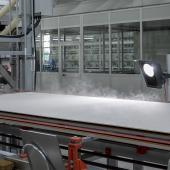The ceramic third fire decoration segment
Total turnover amounted to about 350 million euro in 2002. The sampled companies reported a turnover of about 147 million euro, 2.7% down on the 151 million euro of 2001.
The shift in production towards accents and trim pieces, which are increasingly in demand from ceramic companies through outsourcing, is tending to push up current turnovers and fuel optimistic forecasts. For 2003, a 2% shift towards outsourcing in the breakdown of turnover is expected. The breakdown between floor and wall tiles remains stable at 33% and 67% of turnover respectively.
Company dimensions continue to increase. On average each company employs about 50 people, although the number of companies with more employees has risen by four percentage points. The operations performed have also become increasingly diversified and involve higher added value. 83% of sampled companies perform complete cycle production, while an equally high percentage (86%) carry out research and design activities focusing on aesthetics, product characteristics, raw materials and glazes. About 35% of designs are subsequently placed on the market where they remain for about two years.
The sampled companies have a good technological level. On average each company has 10 machines, one for every five employees. The number of machines for glass granule applications is high, while the number of roller kilns and screen printing lines is falling (although still high). The number of machines for cold applications and for specific processes is increasing.
The most serious problem faced by companies in the segment is the small size of orders, followed by excessively short delivery times, non-remunerative prices and long payment times. A comparison with the figures from the previous survey reveals a worsening of the problems of excessively small orders and non-remunerative prices, which have increased respectively by 16% and 12% since 2000.
The constraints on development include excessive competition, low receptivity of the market to the products and services on offer and difficulties in recruiting qualified personnel.
The difficulty in forming alliances and the small size of companies are two significant problems at a time when companies must create groups in order to avoid being forced out of the market by the fierce competition.
Did you find this article useful?
Join the CWW community to receive the most important news from the global ceramic industry every two weeks
Recent articles
Cersaie 2025 already booked out
Jun 27, 2025
GMM USA installs IMAnalytics system in the USA
Jun 26, 2025
















